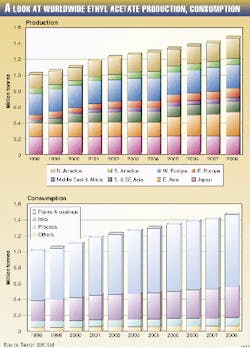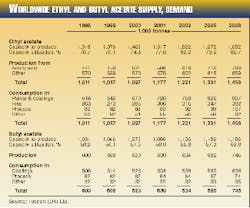The worldwide consumption of ethyl acetate and butyl acetate is expected to rebound by 2008 as chemical manufacturers switch to these solvents to reduce the release of volatile organic compounds into the atmosphere, according to a study by Tecnon (UK) Ltd., London. The study predicts production of ethyl acetate will grow by 3.7%/year until 2008, and production of butyl acetate will grow by 1.4%/ year.
Acetates
In the US, the consumption of ethyl acetate is increasing rapidly. One of the primary reasons for this growth is the increasing substitution of ethyl acetate for methyl ethyl ketone (MEK) as a solvent. In 1990, the US Environmental Protection Agency defined MEK as a hazardous air pollutant (HAP).
"Users of MEK and other HAPs are required to install equipment to destroy or recycle HAPs after use. In many cases, it is easier for coatings manufacturers to switch to alternative solvents for their coatings or move away from organic solvent-based technology," the Tecnon study noted. Similarly, the consumption of butyl acetate has risen because of its increasing replacement for aliphatic ketones (MEK and methyl isobutyl ketone) and aromatic hydrocarbon solvents (toluene and xylene).
"While legislative and other pressures in the US are moving paint and coatings producers and producers of other solvent-using materials away from some solvents and towards acetate esters, there is other pressure on paint and coatings producers to move away from the use of solvents altogether," Tecnon said.
Production and consumption
The Tecnon study shows that, in 1998, total worldwide ethyl acetate capacity was 1,318,000 tonnes/year. Production and consumption were 1,011,000 tonnes.
Tecnon predicts that, in 1998-2008, world ethyl acetate production will grow by an average of 3.7%/year, while capacity grows by an average of 2.5%/year (see chart). The top producer of ethyl acetate in 1998 was Western Europe, contributing 27% of the total output worldwide. Japan followed with 21.8%, and North America was third with 17.8%. Capacity utilization in 2000 is expected to decrease to 74.8% and then increase to 86.7% by 2008 (see table).
In 1998, total worldwide butyl acetate capacity was 1,031,000 tonnes/ year, and production and consumption were 600,000 tonnes, according to Tecnon's report. Worldwide production of butyl acetate in 1998-2008 will grow by 2.2%/year on average, while capacity growth will average 1.4%/year average. Capacity utilization in 2000 is expected to decrease to 57.6% and then increase to 62.8% by 2008.




